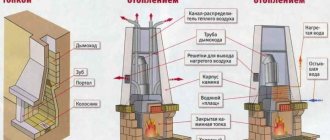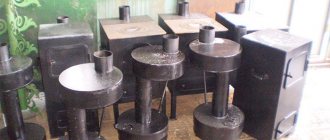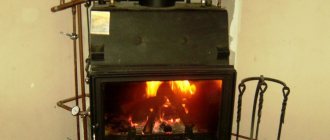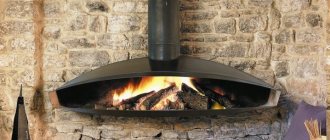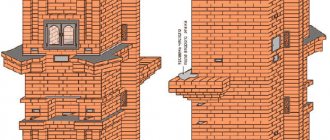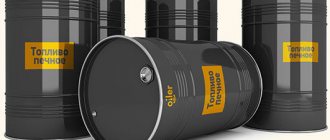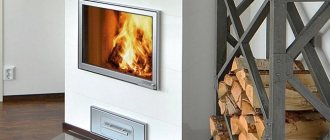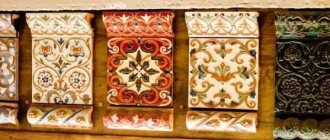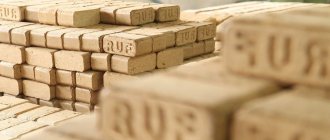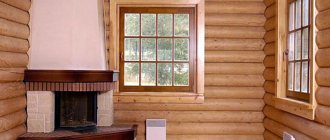If you have a fireplace in your home and are wondering what kind of firewood is needed for a light, pleasant atmosphere and long-lasting heat, you have come to the right place! It is in this article that we will talk about which firewood is most suitable for burning it, as well as the methods for preparing, storing and drying it.
But first, let's figure out how firewood of different types of wood differs from each other:
Quality
The heat transfer of fuel when burning a fireplace depends on the wood itself, its density, degree of dryness, and even on how long and under what conditions it was stored. In addition, you cannot use firewood taken from rotten old wood: they not only burn poorly, but also emit an unpleasant odor.
Dryness
In a freshly felled tree, the presence of moisture can reach 50%. Firewood of this type will not burn well, so it must be dried so that no more than 15% moisture remains.
Finding out the dryness of logs is quite easy: knock two pieces against each other and if you hear a ringing sound, it means the firewood is suitable for the firebox. In addition, fresh firewood is almost twice as heavy as dried firewood.
Density
High density wood is the best wood for your fireplace. The higher this parameter is, the more heat they will give off. Wood comes in the following types: hard, medium-hard and soft.
Hardwoods are birch, oak, beech and hornbeam. This kind of wood is very good for heating a bathhouse. Oak has the highest combustion temperature; its firewood smolders for a long time, thereby maintaining heat. But they are quite expensive, so they often use birch firewood to fire the fireplace. They burn evenly and hotly, filling the air with a pleasant aroma and disinfecting it.
Important! Birch firewood for a fireplace has one drawback: when burned, it releases tar, which remains on the walls of the chimney. To avoid this, you need to place aspen firewood at the end of the firebox.
Medium hardwoods are coniferous and fruit trees that have lower calorific properties than birch or oak. Wood for the fireplace from apple or pear trees flares up and burns well, saturating the air in the house with a pleasant aroma, but “cherry” is more difficult to light, and it can also smoke. A very good option for sauna stoves are logs made of spruce, cedar, pine and larch. When burned, they distribute very beneficial essential oils and a good aroma.
Soft and loose wood species are alder and aspen. This is an excellent option for fireplaces and sauna fireboxes “black”. Alder and aspen firewood contains little moisture, so when burned it produces a minimum of smoke and a minimum of soot. Why they can be burned and to clean chimneys from soot and soot formed in them. But the calorific value of such species is not very high, so to obtain good heat it is better to use a combination of birch and aspen (alder) firewood.
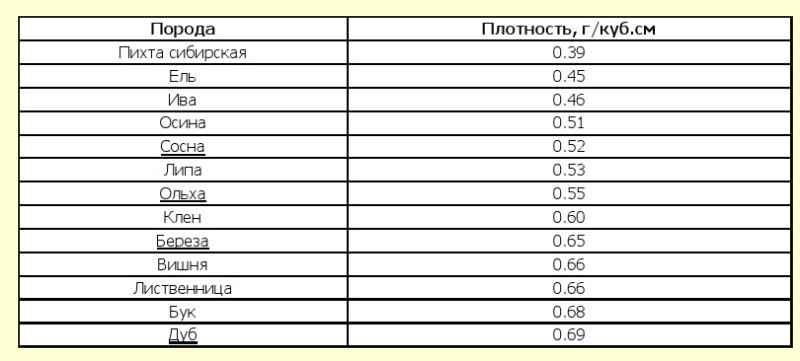
When should I prepare wood for the fireplace?
Since ancient times, people have known that they need to start collecting firewood in late autumn, and continue in winter:
- In autumn, the flow of tree sap in the trees stops, which means the wood has become drier.
- Frozen wood is easier to split.
- In addition, sawing and cutting down trees is much easier with already fallen leaves.
- If you prepare firewood in winter, then over the summer it will dry well and be ready for use. in winter they will be ready for use.
Preparation
Before dealing with fire, you should prepare the fireplace for use. Even if you heat it daily, still do not neglect this step for your safety.
- It all starts with a chimney inspection. The accumulation of soot on its walls can lead to uncontrolled combustion, that is, to a fire. Soot contains flammable resins and a substance called creosote. They need to be disposed of in a timely manner.
- While the fireplace insert is not filled with wood, you should check the draft. This is easy to do if you set fire to a piece of old newspaper. If there is draft, the fire flame will clearly deviate towards the chimney.
Each owner independently determines what to light the fireplace with, but there are a number of tips that you need to heed. Each of us has wondered why dry wood burns better. Damp firewood contains moisture between the fibers. It is necessary to transfer the amount of heat for a long time so that it completely evaporates, and only then the firewood will ignite.
Dry firewood, ready to use
Therefore, if you have a wood-burning fireplace, you should use only dry logs, preferably hardwood. Of course, you can melt it with wet wood, but it will require a lot of effort from you. A freshly felled tree is suitable for firewood after a year of proper drying, so owners of wood-burning fireplaces have pre-prepared supplies in woodpiles.
There are also certain requirements for the external parameters of firewood. Their length should not exceed 40 cm and be about? parts of the firebox width. As for specific breeds, preference should be given to those that provide more heat. Examples include beech, yew, oak, and birch. It is not recommended to use coniferous trees, as the resin they contain will produce a lot of soot and smoke.
Rules for storing firewood
To get high-quality fuel for the fireplace, you need to know how to stack the firewood so that it dries quickly and does not rot.
There are several options for stacking firewood in a woodpile, namely:
- Woodpile stack. It is located near the fence or along the “blank” wall of the house. At the ends, 4 strong stakes are driven into the ground, and a flooring of stones, boards or bricks is placed between them so that the firewood is not on the ground. The logs are stacked with a slight slope back, so that the ends look out. This installation method, although it takes up little space, is not very stable. Therefore, for storing firewood, it is better to set aside a special place - a closed firewood shed with wooden walls and floor.
- If there is no designated room for storing firewood, then stack it in an open space in the form of a house or a stack - in a circle. When laying, it is necessary to create a slight slope so that rainwater does not flow into the woodpile. The stability of this method of laying will depend on how to stack the firewood - this must be done very carefully, without piling logs on top of each other, but finding a suitable place for each of them.
How to store firewood
The traditional way to store logs and chopped firewood is in a woodpile next to the wall of the house or under a canopy. Fuel is stored in large quantities, sufficient for heating for the entire cold season, and sometimes for two to three years (depending on consumption and the size of the woodpile). This option is good for a private cottage where people live permanently and there is no risk of firewood being stolen. In other cases, it is worth building a closed woodshed. More storage options:
- stand - a structure placed next to the fireplace, in which a volume of firewood is placed for several hours or weeks (the dimensions depend on the time);
- basket - placed on the floor or rack in close proximity to the stove, allows you to both store firewood and transfer it from the woodshed to the house;
- a bag is another option for carrying and temporarily storing fuel near the fireplace.
Inventories are created as follows. The raw wood, after sawing and splitting, is laid in rows in a woodpile. They are kept in this form for 3–4 months, depending on the time of preparation of firewood, so that they reach a humidity of 20% or less. They can only be kept outdoors in relatively dry climates. If the region is characterized by rainy weather, it is recommended to immediately hide the fuel under the roof. Otherwise, it will begin to rot, and an unpleasant odor will appear when burning. In addition, rotten wood produces less heat, more smoke and ash. If you follow the rules, firewood can be stored for many years without compromising its heat capacity.
Drying
The best firewood for a fireplace can be purchased already dried using an industrial method: in an electric field or in a special chamber. But it's quite expensive. Therefore, it is better to learn how to dry them naturally. Moreover, on a personal plot or dacha you can always find a place for a woodshed or woodpile, where the firewood will dry out in any weather.
If the firewood for the fireplace is prepared in the fall or winter, it will dry out quite quickly under the roof if the sides of the woodpile are left open. If there is no woodshed, then the woodpile needs to be covered with film or roofing felt, but only on top.
In winter, the firewood does not so much dry out as it cools down, even freezes; The main drying process still occurs in the warm season. However, if you understand how to stack them and can do it correctly, then even with high air humidity, your logs will not stop drying.
The most important stage
Everything is ready to start lighting the fireplace. This process is considered a highlight, as it requires a certain skill and endurance. Many hobbyists are skeptical about modern means of automatic ignition, considering it unnatural. However, not everyone is able to light firewood with one match. Therefore, you should follow all the recommendations, which begin with the methods of stacking firewood:
- If the fireplace is not being lit for the first time, then you should not remove all the ash remaining from the previous use from the grate. A small layer of it serves as excellent thermal insulation protection. It will protect the fireplace body from overheating and prevent cold air from entering the firebox through the ash pan.
- Any kindling of a fireplace begins with the stacking of firewood. The classic method involves placing thicker ones on small branches or splinters. Gradually, the wood pyramid is formed by logs of larger diameter. The most important thing is to leave enough space between layers to allow air flow.
Preparing to light the fire
- An alternative method is reverse laying. It consists in placing thick logs on the bottom. Thinner firewood is placed perpendicular to them. By alternating the direction of placement and reducing the diameter of the firewood, we come to the conclusion that there will be small kindling on top. As a result, the fire will move from top to bottom. This method gives the effect of a closed firebox, that is, longer burning of wood, and therefore greater heat release.
- Before lighting the fireplace, you need to check the draft again. If the room is cool enough, there may be no draft due to cold and damp air in the chimney. To prevent the fireplace from smoking when you ignite, you need to open the forward valve in the pipe and warm the air using an old newspaper. Once the draft appears, you can begin to light the fireplace. Make sure the ash pan or ash door is open.
- It is convenient to light firewood with paper. Roll it up and light it with a match. Then take it to the wood well and slip it between it and a layer of old ash. When the wood begins to burn on its own, you will have to close the glass screen, if any, so that sparks do not fly beyond the space limited by the firebox.
Beautiful flame in the firebox
Heating a fireplace with wood is a big responsibility. Incorrect actions may result in heat loss or fire. It is necessary to correctly assess the intensity of combustion. It can be adjusted by slightly opening or closing the ash pan door. Typically, the correct combustion mode is accompanied by the crackling of firewood and a slight hum of warm air escaping in the pipe. A strong hum is a sign of excessive draft and will cause the wood to quickly burn out, and all the heat will escape into the chimney.
You can assess the position of the ash door by the color of the flame of the melted fireplace; it should be bright yellow. An increase in brightness, up to white, indicates an excess of oxygen, a dark flame indicates its deficiency.
Don't try to fill the firebox with too much wood. This will hardly increase the burning time, and all the heat will go down the drain. In addition, you risk damaging the fireplace. Cracks that appear in bricks due to their strong heating cannot be repaired with anything; smoke will constantly break through them.
Live fire in an open hearth
You cannot use different methods to put out a fire in a fireplace. Temperature changes can cause the firebox finishing materials to burst. The logs should burn out and go out on their own. As a last resort, if you urgently need to leave the house, you should remove the smoldering coals and extinguish them outside the fireplace.
The chimney damper cannot be closed immediately, since carbon monoxide is still released from the smoldering coals. But an open view will lead to heat loss, so you should look for a neutral solution - close it a couple of hours after the fireplace has cooled down.
The rules that tell you how to properly light a fireplace are also relevant if the fireplace is coal-fired. The only difference is in the kindling process. To light a coal-fired fireplace, you should light wood chips and splinters, on which a small layer of special fireplace coal is applied. After waiting for the flame to settle, feel free to add large coarse coals and adjust the draft as described above.
Charcoal is much harder to light than wood, so you often have to use chemicals in the form of tablets. Modern fireplaces are equipped with electric and gas kindlers.
Everyone should think about how to properly light a fireplace stove. This issue addresses safety, not just energy efficiency. First of all, improper use of the firebox can lead to irreparable consequences when a fire destroys everything that is most precious.
But the most dangerous enemy is carbon monoxide, which a person does not feel. Poisoning can occur in your sleep if you close the chimney vent early. When using a fireplace, this happens less often, since the volumes of fuel burned are small compared to a stove, but these rules should be followed in any case.
Before lighting the fireplace, you need to thoroughly ventilate the room. The main thing is to try not to cool the room too much. First you need to find the draft regulator, open it and warm the pipe with air.
This can be done by holding lit paper in the firebox, directly under the chimney. The warmed air will begin to rise upward, and a draft will appear in the pipe. The heat generated when burning wood will also provide good draft.
In order to light the fireplace, you need to put in shavings and small chips, and then small logs. The optimal length of the logs is a quarter less than the width of the opening of the firebox itself. To ensure that the flame in the stove has a pattern, it is best to use hemp and roots. In addition, to color the flame, there are special additives and solutions that can be used to saturate firewood. Plain table salt will give a beautiful yellow color, and copper chloride will provide green and blue reflections of the flame.
When heating with coal, it is better to first place and light small shavings or wood chips. A layer of paper is placed on them, then a small, up to 50 mm, layer of coal is laid out. The paper is set on fire from several sides simultaneously. It is strictly not recommended to light the fireplace with flammable liquids.
When heating with coal, add more coal when the fire is well lit. If it is firewood, place small logs (preferably crosswise) one on top of the other across the entire width of the grate. This is caused by the need to create good air circulation inside the firebox. It is recommended to place the firewood tightly so that the heat emanating from the lower burning logs warms and at the same time dries the upper ones.
You can improve the heat transfer of the stove with the correct arrangement of logs. At the same time, if the firewood is moved slightly forward, more heat will enter the room. Ash located at the rear wall of the firebox will have the same effect.
To use the fireplace correctly and safely, you need to have some tools, such as a poker of sufficient length, log tongs, an ash scoop, and a broom. It is also advisable to purchase fire-resistant mittens and bellows for fanning smoldering coals.
If the room is large, and more firewood is needed to heat it, then they need to be added to the firebox gradually, as the previously laid ones burn out.
The combustion flame should be light and bright. It should burn with an even, calm light. A flame that is too light may indicate excessive draft, while a dark red flame may indicate a lack of draft.
When the stove is operating, the draft regulator must be kept open as much as necessary for uniform combustion. The fire should not make much noise. If no more than an hour has passed before the heat forms from the moment of ignition, then the draft adjustment has been made correctly. You can completely close the damper when the fuel has completely burned out - that is, when the flame does not burn.
Once upon a time, only warm clothes and fire could protect a person and his family from the cold, then humanity came up with a fireplace. And although today central heating, compared to a fireplace, has many advantages, despite this, many prefer to while away the cold evenings by a burning fireplace. How to light a fire correctly so that you get the maximum amount of heat and the wood burns long and evenly? In our article we will tell you how to properly prepare a fireplace for kindling, ignite and stack the wood and then maintain the fire.
The chimney must be cleaned, otherwise a fire may occur in it. So first of all, make sure the chimney is clear. Before lighting the fireplace, check whether the firebox is open. Otherwise, within a few minutes the room will fill with smoke.
The ash that remains from the last time should not be completely removed. A layer of ash of several centimeters will reflect heat into the flame zone. It also protects the walls of the fireplace from excessive heating and does not allow cold air from below into the flame zone.
First, place kindling on the grate. Dry thin branches or a splinter are suitable for this. Place it all crosswise so that there is air access to each layer. Coniferous species are best suited: cedar, pine, etc. Next, lay logs with a diameter of 10 - 15 cm. The longer, the better. As long as they don't touch the walls of the fireplace. Hardwoods are preferable here - maple, oak, hornbeam. Take only dry firewood or purchase it long before use in order to have time to dry it. Store them in a utility room inside the house or in a shelter outside. Place the firewood with a slope towards the room so that the heat goes into the room and not into the chimney. You can push a few sheets of newspaper between the ash and the grate to help with lighting.
There is an interesting way of stacking firewood in a fireplace, when combustion occurs upside down - the fire descends from top to bottom. The method is quite simple. You need to place the largest logs at the bottom close to each other. The second layer is smaller firewood, place it across the bottom layer, also stack them tightly. The third layer is even smaller logs, also compact and across. And so on - up to the required height. Place a splinter or thin dry branches on top. Next, press the paper with small splinters. That's it, you can set the paper on fire. For three hours the fire will burn and the house will be heated. This method produces more heat than conventional methods, since the fire heats the chimney from the very beginning and gives off more heat. There is never any smoke, as the chimney heats up instantly. There is a strong pull from the very beginning. There is no need to mix anything; if everything is put together correctly, the fireplace will burn from 3 to 7 hours. No ash is formed, since each layer burns completely - this confirms the high efficiency of this installation.
The easiest way to light a fireplace is with a piece of rolled newspaper. Light it with a match or lighter and when the torch flares up, place it under the chimney to check the draft. After checking, set fire to pieces of newspaper under the grate. They will set the logs on fire. You can buy ready-made briquettes for lighting a fireplace, but, according to experts, this is not quite right. Once the fireplace is thoroughly hot, close the fireplace screen to prevent sparks from flying into the room. True, a closed screen reduces the amount of heat from the fire. Therefore, you can light the fireplace with the screen open, just make sure that coals and even sparks do not fly out of the fireplace. Keep rugs and other flammable materials away from fire. As soon as the flame becomes weaker, use a poker or tongs to straighten the logs, and they will flare up with renewed vigor. Report logs every half hour. But keep in mind that there should not be too much firewood. Drag the wood that is burning out to the edge of the grate, and place the new ones against the back wall. Always use a poker and tongs to avoid burning your hands.
It is not recommended to put out a fire in the fireplace. You need to wait until the logs burn out and go out naturally. If this process takes too long, never leave the fire unattended. Once the fire has gone out, you can slide the screen and glass door completely shut. Leave the view open for a few more hours until you are sure that the fire has completely gone out. You may have to remove some of the ash. Use a dustpan and brush for this. Do this procedure after the fireplace has completely cooled down, as smoldering embers sometimes persist for a day or even more. Constantly check the chimney to ensure that any soot that accumulates there does not catch fire. Do periodic cleaning.
Choosing a home fireplace is a rather difficult and serious task that must be approached with all responsibility. Today, fireplace inserts are quite widely represented in relevant online stores, but the price of fireplace inserts is either unreasonably high or suspiciously low. That is why our online store “Energy Saving Systems” provides you with the opportunity to buy fireplace inserts with a fair price/quality ratio, at the manufacturer’s price. Our website presents products from the world's best companies with a wide range of power and efficiency.
Who visits our online store?
- People who are confident that home heating costs need to be significantly reduced.
- Those who want to buy a fireplace so that it can bring not only aesthetic pleasure, but also allow them to save money.
- Owners of an open fireplace that does not produce the desired results.
- Home owners who don’t know where to start arranging a heating fireplace.
- Those who wish to order the service of professional installation of a room heating system with a fireplace.
You can buy fireplace inserts for heating in an online store without any hassle or doubt, because it is extremely easy to do. Our managers are always ready to give comprehensive answers to questions that arise from clients. We offer not only to order a fireplace insert in our online store, but also to purchase a fireplace by visiting one of the showrooms in Lviv and Kyiv. In any case, you will be able to receive qualified advice and important recommendations on choosing the appropriate option.
Fireplaces and fireplace inserts for heating – features of selection and application:
When choosing a fireplace, you should understand that it is primarily a heating device. That is why its acquisition should be taken with the utmost seriousness. It is important to consider the technical capabilities, purpose and design features of the models you choose. You also need to remember that fireplace inserts from different manufacturers differ significantly from each other in precisely these indicators. Despite this, externally, fireplace inserts can be very similar.
How to reduce home heating costs?
Fireplace inserts can perform the function of heating equipment: be both the main and auxiliary source of heating in the house. But not every fireplace insert can heat a house. Fireplace inserts can be either for decorative purposes (with intermittent combustion) or with a heating function (continuous combustion).
Two types of functional fireplace inserts will help you save on heating your home:
- — with air heating;
- - with water heating.
To heat a water heating system, you need to buy a fireplace with a water circuit. It will perform the work of a solid fuel boiler and fireplace at the same time. Most often, a water fireplace is used in a system with another heat source, for example, a gas or electric boiler. When the fireplace is operating, the other source is automatically switched off. A fireplace with a water circuit can also independently heat the entire house. This saves money on heating your home.
The efficiency of a fireplace-based air heating system depends on many factors:
A very important indicator is the material used to make the firebox and the thickness of its walls. If it is a cast iron firebox, then it is desirable that it be monolithic. The material must comply with European standards EN - GJL - 200-250. Poor quality material and thin walls will not retain heat, and constant temperature loads can lead to rapid burning of the walls. A fireplace insert for air heating must be designed to operate in a continuous, long-term combustion mode. Only in this case will you get the desired result. The air-heated fireplaces and stoves we offer will provide you with affordable heat and independence from other energy sources.
If it is not possible to install a traditional wood-burning fireplace, and the dream of home comfort with a fireplace does not leave you, we suggest buying an electric fireplace with a 3D flame effect. For country houses or cold rooms, free-standing fireplaces and stoves that do not need finishing are ideal. We can also offer you stoves for baths and saunas.
To purchase a fireplace and order its installation:
You can send us a house plan by email, or order a visit from our specialist to take measurements on site. We will make you a free commercial offer for a fireplace heating system, which will indicate all the necessary equipment.
A good fireplace can really heat up your home quickly. You won't turn your beautiful living room into a boiler room, since you won't have to add wood to the fireplace every hour. Our fireplace inserts allow one load of wood to burn for a long time, even up to 12 hours.
You can buy fireplaces, fireplace inserts in Ukraine or other products presented by us by ordering them by phone or through an online store. In all cities of Ukraine we deliver by transport service.
Determining the required volume
Many summer residents are interested in the following question: how to correctly calculate the cubic capacity of firewood when purchasing, so as not to overpay for it and stock up in abundance?
To calculate the volume of firewood there are special units of measurement and coefficients:
— A storage meter is a carefully laid woodpile, the height, width and depth of which is one meter.
— Cubic meters are calculated with a coefficient of 0.7. This means that 1 sq/m = 0.7 cubic meters.
But since firewood, as a rule, is brought in bulk in a car, in order not to waste your time stacking firewood in a woodpile and calculating its cubic capacity, the volume of the machine body must be multiplied by a factor of 0.82 to get the sum of the storage meters.
Let's consider an example: the length of the car body is 3.5 m, the width is 2 meters, and the height of its sides is 1.5 m, we find out its volume = 3.5 m * 2 m * 1.5 m = 10.5 cubic meters. Next, we multiply the volume by 0.82, resulting in 8.61 storage meters. Then 8.61*0.7 = 6 cubic meters. So, it turned out to be about six cubic meters of firewood, that is, approximately half the volume of the body!!!
Knowing the methods of selection, storage and calculation, you can always determine exactly which firewood is preferable to use for the fireplace and how much firewood you will need to pay for.
Where to buy firewood for the fireplace: price in Moscow
| online store “Mos-firewood” https://drova-moskva.arma-vir.com/ +7 |
Processes that occur when wood is burned
Either way, if all goes well, we will get to the moisture evaporation stage of the wood burning process, where instead of generating heat, heat is absorbed as the water trapped inside the wood turns into steam and is removed from the wood by evaporation. Most often, the observant pyromaniacs among us noticed this phenomenon occurring at the smaller ends of the branches, where the water just below the bark evaporated and flowed into the hearth.
Technically, this first stage of wood burning relies on the wood reaching 100 degrees Celsius as the water in the wood begins to boil and then evaporates.
As we explained in our Guide to Efficient Pool Heating, evaporation takes a lot of energy - which goes against the grain of burning wood for heat, the first rule of burning wood in stoves or fireplaces: dry wood. The maximum moisture content should be considered in the range of 15-20%, so when choosing firewood, consider the moisture content as well as the type of wood.
Unlike moisture in damp or unseasoned logs, volatile gases are flammable. They burn and produce heat. Thus, when the surface temperature of wood rises above 100 °C to approximately 230 °C,
gases rich in creosote are released: carbon dioxide, carbon monoxide, acetic and formic acids. However, since these gases produced in the first stage of combustion do not ignite until all the moisture has evaporated and the kindling temperature is hot enough to ignite them, this results in increased emissions levels. We've said it before - the first rule of wood burning? Dry firewood!
Once this process of evaporation of excess moisture is completed and the temperature in our stove or fireplace rises, this leads to the second stage of wood combustion.
Safety rules for burning a fireplace
A fireplace is an interesting decorative element for any room. But do not forget that everything where there is fire should be as safe as possible. When burning a fireplace, you should adhere to several mandatory rules:
- It is necessary to constantly inspect the combustion opening and chimney, assessing their integrity and degree of contamination. If the fireplace is used very often, a lot of soot and soot will form on the walls of the air duct. Because of this, the draft of the chimney weakens, and the smoke begins to partially leak into the room. If there is a high concentration of carbon dioxide in the room, there is a danger of poisoning or burning.
- Ignition should be carried out gradually. You should first use flammable materials such as small logs, sawdust and old newspapers. And only after they have burned sufficiently, add fuel for greater heat.
- During operation of the fireplace, the damper that regulates the draft in the fireplace must be slightly open.
- Do not throw trash, painted logs, or add flammable liquids into the fireplace. The smoke from such substances is toxic, which can cause poisoning.
It would seem that if you put as much fuel as possible into the fireplace, the flame will burn brighter and there will be more heat. But this is far from true. All the heat will go into the pipe. The fuel will burn the same as with a smaller load. It is also worth remembering that if you fill the firebox to the top with solid fuel, the walls of the fireplace may be damaged, which at best will shorten the life of the stove, and at worst will lead to a fire. Therefore, it is advisable to use fireplace fuel with caution, following certain rules.
Using wood as fuel
Nothing beats a real wood fire. The characteristic crackling sound and live flame are only possible if real logs are used.
There are several nuances on how to properly heat a fireplace with wood:
- It is necessary to follow the rules for storing firewood. You can heat the room only with dry wood, which contains as little moisture as possible. Firewood from freshly cut trees is not suitable. You need to use logs that have been drying for at least a year. Such firewood is easy to distinguish - it has a darker shade compared to other wood, and there are several cracks on its surface. The combustion process of dry wood is characterized by a clearly visible crackling sound.
- You need to choose logs of the same size. The thickness of the tree should be no more than 6-10 cm, otherwise the log will not burn well. The length should be ¾ of the combustion hole.
- To fire the fireplace, a horizontal method of laying firewood is used. The logs are placed in the combustion hole next to each other with a gap of 1 cm. The height of the stack should not exceed 30 cm.
Another important criterion for how to light a stove is the choice of wood species for lighting the fireplace.
What wood is suitable for fireplace inserts?
How warm the room will be after lighting the fireplace, how much soot and smoke there will be - all this depends on the type of wood for kindling. You need to know exactly what kind of wood is best to burn the fireplace with. The following types of wood are used for kindling:
- Hardwood. These include birch, hawthorn, pear and apple. It is a malleable wood that burns easily. During the combustion process, a minimal amount of tar and soot is released.
- Hard rocks. For long burning, it is better to choose oak, yew and beech logs. This type of firewood is difficult to split and takes quite a long time to light. But logs will burn much longer than other types of wood.
- Softwood. Elm, cherry, cedar and fir produce much less heat than other types of wood. In addition, the logs smoke heavily and a large amount of soot and ash is formed. You should refrain from choosing such logs if the fireplace chimney has a rectangular shape and a small hole. If the air duct draft is weak, smoke can fill the room.
- Coniferous species. To create a pleasant aroma in the room, pine and spruce logs are used. Coniferous trees burn quickly, but the flame is uneven and many sparks are produced. A large amount of smoke and soot is also released. Due to the high resin content in coniferous trees, embers may fall out of the fireplace, which is quite unsafe.
- Cleaning rocks. These include alder and aspen. Wood does not emit smoke during combustion. Using alder and aspen firewood not only does not emit soot, but also cleanses the chimney of soot. It is advisable to heat the fireplace during frequent use with cleaning logs at least once every two weeks.
- Fragrant branches. You can add fragrant tree branches to the fireplace flame, which will fill the room with a pleasant smell. You can use branches of fruit trees. Adding juniper branches to the fire will bring a healing and relaxing effect.
Whatever type of wood is used to fire the fireplace, you should choose only dry wood. If tree branches and logs contain a lot of moisture, the fireplace will become covered with soot and soot, which can weaken the draft in the chimney.
